1968 Formula One season
[2] Repco produced a more powerful version of their V8 to help Brabham's compete against Ford's new Cosworth DFV, but it proved very unreliable: Jochen Rindt qualified on pole position twice but also only finished twice.
Lotus replied with a full width wing directly connected to the rear suspension that required a re-design of the wishbones and transmission shafts.
[5] All cars had to be fitted with a rollbar that stretched out to at least 5 cm (2.0 in) above the driver's helmet, an electrical circuit breaker, an oil catch tank and a reverse gear.
[9][10][11] The FIA decided to permit unrestricted sponsorship on cars after the withdrawal of support from automobile related firms like BP, Shell and Firestone.
[5] The fast and flowing Kyalami circuit between Johannesburg and Pretoria played host to the South African Grand Prix for the second time on New Year's Day 1968.
Briton Jim Clark was fastest by a second with his Lotus-Ford/Cosworth teammate Graham Hill alongside him with Jackie Stewart in the new Matra-Ford/Cosworth completing the front row.
On 7 April, Jim Clark, one of the most successful and popular drivers of all time, was killed at Hockenheim in West Germany at a non-championship Formula Two event.
The Scotsman had gone off the track caused by what was believed to be a deflating rear tire; 90% of the Hockenheim circuit was made up of two long, slightly curving straights running through thick forests.
Jackie Stewart was still out of action with a wrist injury from the Jarama F2 race a month earlier and so his place in the Matra International team was taken by F1 debutant Johnny Servoz-Gavin.
Brabham, Dan Gurney and Siffert all went out with mechanical trouble while Beltoise broke his suspension running over a curb and Piers Courage (Reg Parnell Racing BRM) stopped because his car was handling so badly.
As a result, the excitement was limited although third placed Hulme stopped in the mid-race to have a driveshaft replaced and dropped to fifth, leaving Bianchi to finish third behind Hill and Attwood with Lodovico Scarfiotti fourth in the second Cooper-BRM.
Cooper ran only one car for Lucien Bianchi following the death of Scarfiotti and Brian Redman's accident at Spa a fortnight earlier.
In qualifying Chris Amon was fastest in his Ferrari with Jochen Rindt's Brabham and Graham Hill's Lotus sharing the front row.
An all-French team in the form of an Alpine-Renault Grand Prix car was expected to make its debut at its home race, but never materialised, due to its engine lacking 100 brake horsepower compared to the opposition, leading to Renault killing the project.
Cooper fielded Briton Vic Elford and Matra's Johnny Servoz-Gavin to replace the late Ludovico Scarfiotti and the injured Brian Redman while Dan Gurney was missing because of a lack of engines for his Eagle.
The dreadful 1968 season continued on as Graham Hill arrived at Brands Hatch with a big lead in the World Championship and with seven other British drivers in the 20-car field, there was plenty for the fans to cheer.
The only major change from the miserable French GP (where Honda driver Jo Schlesser had been killed) was the arrival in the Cooper-BRM team of Robin Widdows.
On lap 44, Oliver came to a halt with a transmission failure and so Siffert inherited the lead and went on to win his first ever Grand Prix and Rob Walker's first victory in seven years.
After Jo Siffert's unexpected victory for Rob Walker at Brands Hatch, the F1 teams headed off to the most challenging circuit of the year: the 14.2 mi (22.9 km) Nürburgring and more bad weather, the previous four races having all been affected by rain.
The third row featured Jackie Stewart's Matra-Ford, John Surtees in the Honda and Piers Courage in a Reg Parnell Racing BRM.
The Gold Cup non-championship race at the Oulton Park circuit near Manchester, England attracted some of the big names and victory went to Jackie Stewart in his Matra-Ford.
There was a five-week gap in the World Championship calendar between the German and Italian Grands Prix and after a season of rainfall and tragedy the F1 circus was able to take a break.
The entry at the Monza Autodrome near Milan was the biggest of the season with American driver Mario Andretti entered in a third Lotus and his USAC rival Bobby Unser replacing Richard Attwood in the BRM team.
Cooper had been planning to run three cars but Robin Widdows was out of action after an accident and so the team ran only Vic Elford and Lucien Bianchi.
After the successful Canadian GP at Mosport Park near Toronto the previous year, the event was given a more reasonable date in the 1968 calendar, but the race was moved to the exciting Mont Tremblant circuit at St Jovite, in Quebec, one and a half hours northwest of Montreal.
Jochen Rindt took pole position for Brabham—the new Repco engine finally beginning to work—with Chris Amon's Ferrari and Jo Siffert's Rob Walker Lotus alongside on the front row.
McLaren again ran a third car for Dan Gurney while Ferrari replaced Ickx (who had broken his leg in practice for the Canadian GP) with Derek Bell.
A big crowd gathered in the hope that Andretti would be able to beat the F1 regulars and at the start Mario edged into the lead although Stewart overtook him before the end of the first lap.
All the contenders were overshadowed in qualifying by the Swiss Jo Siffert in Rob Walker's Lotus 49 who took pole position with Chris Amon's Ferrari second.
Jacky Ickx was back in action in his Ferrari after missing the US Grand Prix because of a leg injury but his race was also short-lived because of an ignition failure.




